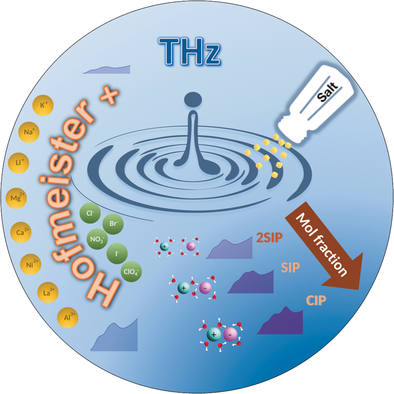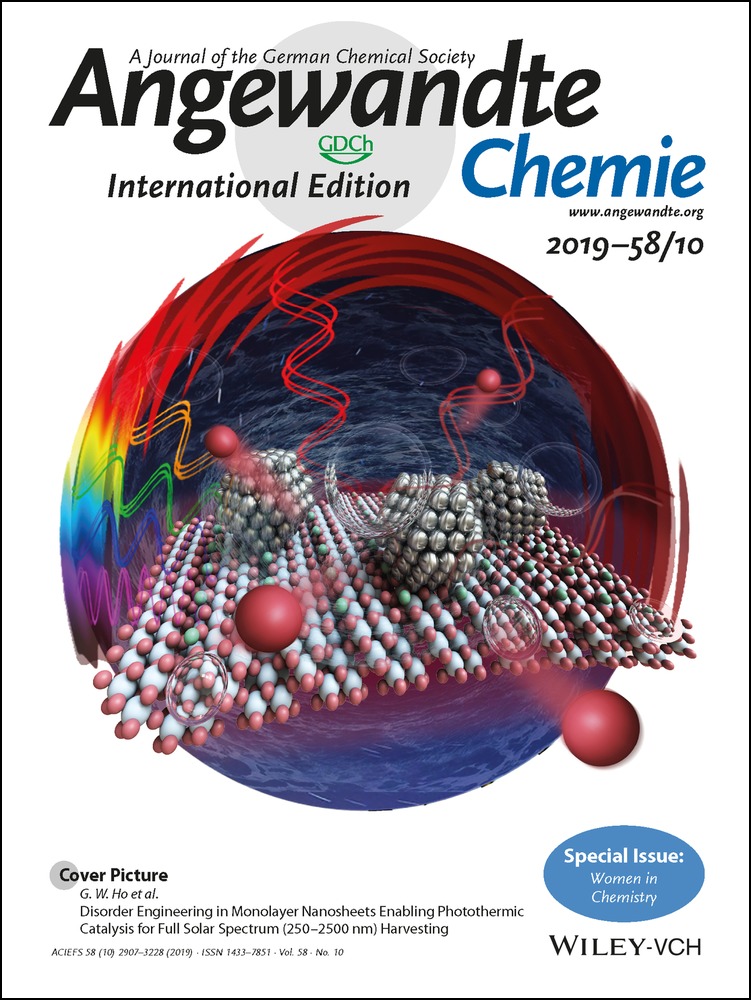Ion Hydration and Ion Pairing as Probed by THz Spectroscopy
Dr. Gerhard Schwaab
Lehrstuhl für Physikalische Chemie II, Ruhr-Universität Bochum, 44780 Bochum, Germany
Search for more papers by this authorDr. Federico Sebastiani
Lehrstuhl für Physikalische Chemie II, Ruhr-Universität Bochum, 44780 Bochum, Germany
Search for more papers by this authorCorresponding Author
Prof. Martina Havenith
Lehrstuhl für Physikalische Chemie II, Ruhr-Universität Bochum, 44780 Bochum, Germany
Search for more papers by this authorDr. Gerhard Schwaab
Lehrstuhl für Physikalische Chemie II, Ruhr-Universität Bochum, 44780 Bochum, Germany
Search for more papers by this authorDr. Federico Sebastiani
Lehrstuhl für Physikalische Chemie II, Ruhr-Universität Bochum, 44780 Bochum, Germany
Search for more papers by this authorCorresponding Author
Prof. Martina Havenith
Lehrstuhl für Physikalische Chemie II, Ruhr-Universität Bochum, 44780 Bochum, Germany
Search for more papers by this authorGraphical Abstract
Testing the water: The microscopic interplay between cations, anions, and water can be understood by THz-FTIR spectroscopy. Dissection of the spectra shows that the full response of the solvating water when dissolving salts can not be explained from the individual properties (such as the ion radius, the ion–water interaction, the structural hydration shell size, etc.) alone; cooperativity effects need to be included.
Abstract
Ion hydration is of pivotal importance for many fundamental processes. Various spectroscopic methods are used to study the retardation of the hydration bond dynamics in the vicinity of anions and cations. Here we introduce THz-FTIR spectroscopy as a powerful method to answer the open questions. We show through dissection of THz spectra that we can pinpoint characteristic absorption features that can be attributed to the rattling modes of strongly hydrating ions within their hydration cages as well as vibrationally induced charge fluctuations in the case of weakly hydrating ions. Further analysis yields information on anion–cation cooperativity, the size of the dynamic hydration shell, as well as the lifetimes of these collective ion-hydration water modes and their connecting thermal bath states. Our study provides evidence for a non-additive behavior, thus questioning the simplified Hofmeister model. THz spectroscopy enables ion pairing to be observed and quantified at a high salt concentration.
Conflict of interest
The authors declare no conflict of interest.
Supporting Information
As a service to our authors and readers, this journal provides supporting information supplied by the authors. Such materials are peer reviewed and may be re-organized for online delivery, but are not copy-edited or typeset. Technical support issues arising from supporting information (other than missing files) should be addressed to the authors.
| Filename | Description |
|---|---|
| anie201805261-sup-0001-misc_information.pdf1.1 MB | Supplementary |
Please note: The publisher is not responsible for the content or functionality of any supporting information supplied by the authors. Any queries (other than missing content) should be directed to the corresponding author for the article.
References
- 1Y. Marcus, Chem. Rev. 2009, 109, 1346–1370.
- 2Y. Zhang, P. Cremer, Curr. Opin. Chem. Biol. 2006, 10, 658–663.
- 3D. J. Tobias, J. C. Hemminger, Science 2008, 319, 1197–1198.
- 4H. Ohtaki, T. Radnai, Chem. Rev. 1993, 93, 1157–1204.
- 5L. Helm, A. E. Merbach, Chem. Rev. 2005, 105, 1923–1960.
- 6H. J. Bakker, Chem. Rev. 2008, 108, 1456–1473.
- 7R. Buchner, G. Hefter, Phys. Chem. Chem. Phys. 2009, 11, 8984.
- 8T. Dodo, M. Sugawa, E. Nonaka, H. Honda, S. Ikawa, J. Chem. Phys. 1995, 102, 6208.
- 9H. Kanno, J. Phys. Chem. 1988, 92, 4232–4236.
- 10P. N. Perera, B. Browder, D. Ben-Amotz, J. Phys. Chem. B 2009, 113, 1805–1809.
- 11D. T. Bowron, S. Diaz Moreno, Coord. Chem. Rev. 2014, 277, 2–14.
- 12J. E. Enderby, Chem. Soc. Rev. 1995, 24, 159–168.
- 13G. W. Neilson, P. E. Mason, S. Ramos, D. Sullivan, Philos. Trans. R. Soc. A 2001, 359, 1575–1591.
- 14K. Nygård, M. Hakala, S. Manninen, K. Hämäläinen, M. Itou, A. Andrejczuk, Y. Sakurai, Phys. Rev. B 2006, 73, 024208.
- 15Y. L. Jeyachandran, F. Meyer, A. Benkert, M. Bär, M. Blum, W. Yang, F. Reinert, C. Heske, L. Weinhardt, M. Zharnikov, J. Phys. Chem. B 2016, 120, 7687–7695.
- 16S. Funkner, G. Niehues, D. A. Schmidt, M. Heyden, G. Schwaab, K. M. Callahan, D. J. Tobias, M. Havenith, J. Am. Chem. Soc. 2012, 134, 1030–1035.
- 17F. Sebastiani, S. L. P. Wolf, B. Born, T. Q. Luong, H. Coelfen, D. Gebauer, M. Havenith, Angew. Chem. Int. Ed. 2017, 56, 490–495; Angew. Chem. 2017, 129, 504–509.
- 18D. A. Turton, J. Hunger, G. Hefter, R. Buchner, K. Wynne, J. Chem. Phys. 2008, 128, 161102.
- 19I. A. Heisler, S. R. Meech, Science 2010, 327, 857–860.
- 20K. J. Tielrooij, N. Garcia-Araez, M. Bonn, H. J. Bakker, Science 2010, 328, 1006–1009.
- 21S. T. van der Post, K.-J. Tielrooij, J. Hunger, E. H. G. Backus, H. J. Bakker, Faraday Discuss. 2013, 160, 171–189.
- 22M. D. Fayer, D. E. Moilanen, D. Wong, D. E. Rosenfeld, E. E. Fenn, S. Park, Acc. Chem. Res. 2009, 42, 1210–1219.
- 23L. De Marco, J. A. Fournier, M. Thämer, W. Carpenter, A. Tokmakoff, J. Chem. Phys. 2016, 145, 094501.
- 24J. A. Fournier, W. Carpenter, L. De Marco, A. Tokmakoff, J. Am. Chem. Soc. 2016, 138, 9634–9645.
- 25A. Shalit, S. Ahmed, J. Savolainen, P. Hamm, Nat. Chem. 2017, 9, 273–278.
- 26D. Laage, T. Elsaesser, J. T. Hynes, Chem. Rev. 2017, 117, 10694–10725.
- 27B. Hribar, N. T. Southall, V. Vlachy, K. A. Dill, J. Am. Chem. Soc. 2002, 124, 12302–12311.
- 28M. D. Baer, V.-T. Pham, J. L. Fulton, G. K. Schenter, M. Balasubramanian, C. J. Mundy, J. Phys. Chem. Lett. 2011, 2, 2650–2654.
- 29C. N. Rowley, B. Roux, J. Chem. Theory Comput. 2012, 8, 3526–3535.
- 30E. Pluhařová, O. Marsalek, B. Schmidt, P. Jungwirth, J. Phys. Chem. Lett. 2013, 4, 4177–4181.
- 31B. Lev, B. Roux, S. Yu. Noskov, J. Chem. Theory Comput. 2013, 9, 4165–4175.
- 32G. Stirnemann, E. Wernersson, P. Jungwirth, D. Laage, J. Am. Chem. Soc. 2013, 135, 11824–11831.
- 33M. Śmiechowski, J. Sun, H. Forbert, D. Marx, Phys. Chem. Chem. Phys. 2015, 17, 8323–8329.
- 34Z. R. Kann, J. L. Skinner, J. Chem. Phys. 2016, 144, 234501.
- 35U. Baul, S. Vemparala, Phys. Rev. E 2015, 91, 012114.
- 36A. Vila Verde, M. Santer, R. Lipowsky, Phys. Chem. Chem. Phys. 2016, 18, 1918–1930.
- 37D. Laage, J. T. Hynes, Science 2006, 311, 832–835.
- 38D. Laage, G. Stirnemann, F. Sterpone, J. T. Hynes, Acc. Chem. Res. 2012, 45, 53–62.
- 39J. D. Smith, R. J. Saykally, P. L. Geissler, J. Am. Chem. Soc. 2007, 129, 13847–13856.
- 40K. M. Callahan, N. N. Casillas-Ituarte, M. Roeselovaá, H. C. Allen, D. J. Tobias, J. Phys. Chem. A 2010, 114, 5141–5148.
- 41J. L. Fulton, G. K. Schenter, M. D. Baer, C. J. Mundy, L. X. Dang, M. Balasubramanian, J. Phys. Chem. B 2010, 114, 12926–12937.
- 42C. H. Giammanco, D. B. Wong, M. D. Fayer, J. Phys. Chem. B 2012, 116, 13781–13792.
- 43J. Mähler, I. Persson, Inorg. Chem. 2012, 51, 425–438.
- 44W. W. Rudolph, G. Irmer, Dalton Trans. 2013, 42, 3919–3935.
- 45R. Zhang, W. Zhuang, J. Phys. Chem. B 2013, 117, 15395–15406.
- 46K. F. Rinne, S. Gekle, R. R. Netz, J. Chem. Phys. 2014, 141, 214502.
- 47M. Kohagen, E. Pluhařová, P. E. Mason, P. Jungwirth, J. Phys. Chem. Lett. 2015, 6, 1563–1567.
- 48Y. Chen, H. I. Okur, N. Gomopoulos, C. Macias-Romero, P. S. Cremer, P. B. Petersen, G. Tocci, D. M. Wilkins, C. Liang, M. Ceriotti, S. Roke, Sci. Adv. 2016, 2, e 1501891.
- 49P. Schienbein, G. Schwaab, H. Forbert, M. Havenith, D. Marx, J. Phys. Chem. Lett. 2017, 8, 2373–2380.
- 50A. W. Omta, Science 2003, 301, 347–349.
- 51D. Paschek, R. Ludwig, Angew. Chem. Int. Ed. 2011, 50, 352–353; Angew. Chem. 2011, 123, 368–370.
- 52N. Schwierz, D. Horinek, U. Sivan, R. R. Netz, Curr. Opin. Colloid Interface Sci. 2016, 23, 10–18.
- 53P. Jungwirth, P. S. Cremer, Nat. Chem. 2014, 6, 261–263.
- 54Y. Marcus, G. Hefter, Chem. Rev. 2006, 106, 4585–4621.
- 55N. F. A. van der Vegt, K. Haldrup, S. Roke, J. Zheng, M. Lund, H. J. Bakker, Chem. Rev. 2016, 116, 7626–7641.
- 56P. Jungwirth, J. Phys. Chem. B 2014, 118, 10333–10334.
- 57C. J. Fennell, A. Bizjak, V. Vlachy, K. A. Dill, J. Phys. Chem. B 2009, 113, 6782–6791.
- 58K. D. Collins, Biophys. J. 1997, 72, 65–76.
- 59C. Held, T. Reschke, S. Mohammad, A. Luza, G. Sadowski, Chem. Eng. Res. Design 2014, 92, 2884–2897.
- 60D. A. Schmidt, Ö. Birer, S. Funkner, B. P. Born, R. Gnanasekaran, G. W. Schwaab, D. M. Leitner, M. Havenith, J. Am. Chem. Soc. 2009, 131, 18512–18517.
- 61V. Sharma, F. Böhm, M. Seitz, G. Schwaab, M. Havenith, Phys. Chem. Chem. Phys. 2013, 15, 8383.
- 62V. Sharma, F. Böhm, G. Schwaab, M. Havenith, Phys. Chem. Chem. Phys. 2014, 16, 25101–25110.
- 63F. Böhm, V. Sharma, G. Schwaab, M. Havenith, Phys. Chem. Chem. Phys. 2015, 17, 19582–19591.
- 64C. Klinkhammer, F. Böhm, V. Sharma, G. Schwaab, M. Seitz, M. Havenith, J. Chem. Phys. 2018, 148, 222802.
- 65M. J. DiTucci, F. Böhm, G. Schwaab, E. R. Williams, M. Havenith, Phys. Chem. Chem. Phys. 2017, 19, 7297–7306.
- 66J. Bertie, Z. Lan, Appl. Spectrosc. 1996, 50, 1047–1057.
- 67D. Decka, G. Schwaab, M. Havenith, Phys. Chem. Chem. Phys. 2015, 17, 11898–11907.
- 68O. Kristiansson, J. Lindgren, J. De Villepin, J. Phys. Chem. 1988, 92, 2680–2685.
- 69M. Śmiechowski, J. Stangret, J. Phys. Chem. A 2007, 111, 2889–2897.
- 70C. Allolio, N. Salas-Illanes, Y. S. Desmukh, M. Ryan Hansen, D. Sebastiani, J. Phys. Chem. B 2013, 117, 9939–9946.
- 71Y. Marcus, Chem. Rev. 1988, 88, 1475–1498.
- 72A. Nitzan, Chemical Dynamics in Condensed Phases: Relaxation, Transfer, Reactions in Condensed Molecular Systems, Oxford University Press, Oxford, 2006.
- 73P. E. Mason, S. Ansell, G. W. Neilson, S. B. Rempe, J. Phys. Chem. B 2015, 119, 2003–2009.
- 74H. J. Kulik, N. Marzari, A. A. Correa, D. Prendergast, E. Schwegler, G. Galli, J. Phys. Chem. B 2010, 114, 9594–9601.
- 75A. K. Soper, K. Weckström, Biophys. Chem. 2006, 124, 180–191.
- 76S. Ramos, A. C. Barnes, G. W. Neilson, M. J. Capitan, Chem. Phys. 2000, 258, 171–180.
- 77V. Mile, L. Pusztai, H. Dominguez, O. Pizio, J. Phys. Chem. B 2009, 113, 10760–10769.
- 78S. Ramos, G. W. Neilson, A. C. Barnes, M. J. Capitán, J. Chem. Phys. 2003, 118, 5542–5546.
- 79B. Beagley, C. A. McAuliffe, S. P. B. Smith, E. W. White, J. Phys. Condens. Matter 1991, 3, 7919–7930.
- 80P. D′Angelo, M. Benfatto, J. Phys. Chem. A 2004, 108, 4505–4514.
- 81P. D′Angelo, V. Barone, G. Chillemi, N. Sanna, W. Meyer-Klaucke, N. Viorel Pavel, J. Am. Chem. Soc. 2002, 124, 1958–1967.
- 82S. Diáz-Moreno, S. Ramos, D. T. Bowron, J. Phys. Chem. A 2011, 115, 6575–6581.
- 83P. G. Allen, J. J. Bucher, D. K. Shuh, N. M. Edelstein, I. Craig, Inorg. Chem. 2000, 39, 595–601.
- 84M. Heyden, J. Sun, S. Funkner, G. Mathias, H. Forbert, M. Havenith, D. Marx, Proc. Natl. Acad. Sci. USA 2010, 107, 12068.
- 85K. Winkel, M. Seidl, T. Loerting, L. E. Bove, S. Imberti, V. Molinero, F. Bruni, R. Mancinelli, M. A. Ricci, J. Chem. Phys. 2011, 134, 024515.
- 86L. F. Cameretti, G. Sadowski, J. M. Mollerup, Ind. Eng. Chem. Res. 2005, 44, 3355–3362.
- 87H. Kanno, J. Hiraishi, J. Raman Spectrosc. 1982, 12, 224–227.
- 88R. Zhao, P. Pan, Can. J. Chem. 2001, 79, 131–144.





